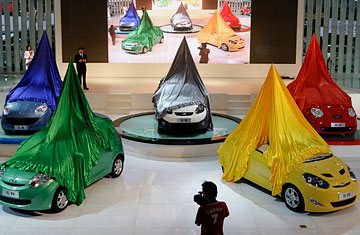
The new Chery Wuwa series are unveiled at the Auto China 2008 show in Beijing in April 2008
While the U.S. has been debating how to bail out GM and Chrysler during the worst auto industry slump in decades, China has been scrambling to come up with its own rescue plan for its ailing carmakers. But unlike Washington, which is providing billions of dollars to prop up the balance sheets of the Detroit giants, China is taking a different route: it's trying to get consumers to buy more cars through a sales tax break and targeted subsidies for rural buyers.
On Jan. 20, the Beijing government slashed the sales tax on cars with engines of up to 1.6 liters from 10% to 5%. The measure, designed to get Chinese to buy smaller, more fuel-efficient vehicles, has had an immediate impact. January sales of small cars jumped 19% compared with the previous month, according to the China Association of Automobile Manufacturers. Also boosting buyer interest: Lower road taxes and fuel prices, which are set by the government. (See TIME's picks of the 50 worst cars of all time.) The surge in small-car sales helped China pass a milestone. For the first time ever, more cars were sold in China (735,000 vehicles) in a month than were sold in the U.S. (657,000). In January at least, China was the world's largest car market. "The tax reduction was an obvious help to our sales," says a sales manager surnamed Feng at the biggest Hyundai dealer in Beijing. "Since the new policy started, sales of our three models with 1.6 liter engines or below have gone up by 30% compared to the same period last year." Ultimately Chinese carmakers, not foreign manufacturers like Hyundai, are expected to benefit most from Beijing's moves. "Domestic manufacturers mostly focus on the production of automobiles with smaller engine power, and they benefit the most from the tax reduction policy," says Yao Jie, deputy secretary general of China Association of Automobile Manufacturers. While domestic brands accounted for 26% of the market last year, their share climbed to 30% in January, Yao says. Chery Automobile Co, the highest-selling Chinese automaker and manufacturer of the popular QQ compact, says it expects to increase sales by 18% this year. The tax cuts are part of China's efforts to revive its economy, which is suffering from dramatic drops in exports and investment, through a wide range of stimulus measures. In November Beijing announced it will spend $586 billion this year to promote growth. While few details of the stimulus plan have been made public, the government says it will use tax cuts and loans to aid 10 key industries including machinery manufacturing, steel, textiles, oil, shipbuilding and electronics. (See 10 things to do in Beijing.) China's stimulus plans "could have an enormous difference in whether or not people want to buy cars," says Ben Simpfendorfer, chief China economist for the Royal Bank of Scotland. "What's unusual about this cycle is that China faces the same problems as everywhere else in the world. The big question is how to spur consumer spending. Strong auto sales will help China, just like they'll help America or Europe." No one is saying China's carmakers have turned the corner. Despite stimulus measures, the country's overall car in January were down 14% compared with the same period a year ago (U.S. sales fell 37%). The government has targeted a 10% expansion this year. But Michael Dunne, a Shanghai-based analyst with research firm JD Power, estimates that based on January figures, the mainland's auto market this year will shrink for the first time in 20 years. Beijing has signaled that it intends to use this slowdown to consolidate the country's sprawling auto industry. China has more than 100 carmakers. Chinese media outlets are reporting that the government hopes to reduce 14 major carmakers to 10 this year. At the same time Beijing's economic planners would like to contain the industry's production capacity, which expanded greatly in recent boom years. "So far China has gotten away with that growth," says Dunne, but the slowdown puts "unprecedented pressure on weaker makers. Everybody looked good when you were growing at 20%." Beijing is also trying to prop up the healthiest companies by encouraging car sales in China's rural provinces, where there are hundreds of millions who have yet to adopt the freer spending patterns of consumers in richer coastal cities. Beginning in March the government will offer $730 million in subsidies to help rural residents replace their outdated three-wheeled vehicles, which are ubiquitous in farming communities, with small trucks or minivans with engine capacities of up to 1.3 liters. Qualified individuals will be entitled to a maximum of $725 under the program. Several domestic manufacturers are developing small trucks and minivans to suit the government program, while expanding sales and service networks into the countryside. This year Chang'an, manufacturer of China's leading minivan, plans to add 1,000 sales and service outlets to its existing 1,260. But its unclear if poor rural consumers can be convinced to spend. "Where's the money?" says Dunne. "The Chinese market has proven pretty stubbornly resistant" to efforts to get rural Chinese to open their wallets. Still, the recession could help Beijing push through changes to help the car industry grow more steadily in the long run. That, says Simpfendorfer, is one of the key differences between industry rescue efforts in the U.S. and China. "The Chinese auto sector is not as well entrenched as the interests in the auto sector in the U.S.," he says. "In the U.S. it's a century old [industry]; In China it's not even decades old but a decade old." China has "a greater tolerance to pain" that will allow the country "to push ahead with industrial restructuring that hurts but will ultimately produce a much healthier auto sector."— With reporting by Lin Yang / Beijing
